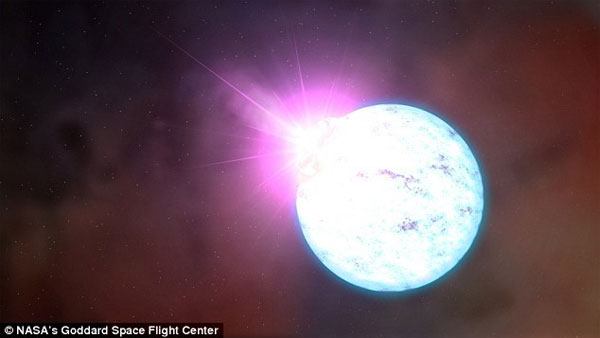For the first time, a star has been discovered in a star
Astronomers discovered the star in a giant gas star about 200,000 light-years from Earth.
In 1975, Dr. Kip Thorne and Dr. Anna Zytkow - two astronomers - each predicted the existence of another star. They argue that they form when a pulsar (ultra-fast rotating star) collides with a giant gas star. Then the giant gas star swallowed pulsed stars. So today astronomers call such stars the Thorne-Zytkow object .

Illustration of the scene of neutron stars colliding with giant gas stars.(Photo: NASA)
Normal stars exist by fusion reactions in their cores, while Thorne-Zytkow stars exist because of the magnetic pulse star that it "swallows".
Nearly 40 years later, astronomers discovered the first Thorne-Zytkow object . Dr. Emily Levesque, an astronomer from the University of Colorado Boulder in the United States, and colleagues discovered neutron stars inside gas stars after they observed the universe with the Magellan Clay telescope (diameter up to 6, 5m) in Chile, Daily Mail reported.
HV 2112 , the name of the gas star, is about 200,000 light-years from Earth. "Studying such stars is very interesting, because it shows us a whole new kind of celestial body , " Ms. Emily commented. Pulse stars (or neutron stars) are objects that rotate very quickly with an expression like radio waves. The material density of the pulsar is very large. A pulsar with a diameter of 20 km has a mass of 1.3 to 2.5 times the sun. If we put the amount of material equivalent to a finger on the scale, we will see its mass of more than one billion tons.
- The scientists were skeptical of discovering Star Death
- The mysterious age of the mysterious star
- The star is brighter than the Sun.
- The first time a revived star was discovered
- Found another star that mysteriously dimmed
- Discover the most 'senior' star in the universe
- The giant red star revives 'zombie star' that confuses the researcher
- The supernova of the wild cousin of SN 1987A
- Astronomers have just discovered the first ribbon around a star
- Spot the first star of the universe
- Discovering a tiny star, about 600 light-years away from Earth
- Predict the time of planetary death
 Van Allen's belt and evidence that the Apollo 11 mission to the Moon was myth
Van Allen's belt and evidence that the Apollo 11 mission to the Moon was myth The levels of civilization in the universe (Kardashev scale)
The levels of civilization in the universe (Kardashev scale) Today Mars, the sun and the Earth are aligned
Today Mars, the sun and the Earth are aligned The Amazon owner announced a secret plan to build a space base for thousands of people
The Amazon owner announced a secret plan to build a space base for thousands of people NASA discovers two stars colliding so violently that they created gold
NASA discovers two stars colliding so violently that they created gold  James Webb Telescope Discovers Massive Supercluster Hidden Deep in the Milky Way
James Webb Telescope Discovers Massive Supercluster Hidden Deep in the Milky Way  'Time travel' 13.5 billion years, NASA telescope finds 4 cosmic ancestors
'Time travel' 13.5 billion years, NASA telescope finds 4 cosmic ancestors  Why there are no stars in American photos of the Moon
Why there are no stars in American photos of the Moon  Aliens control the fastest moving stars in the galaxy?
Aliens control the fastest moving stars in the galaxy?  First 'hybrid' star and planet object revealed outside the Milky Way
First 'hybrid' star and planet object revealed outside the Milky Way 